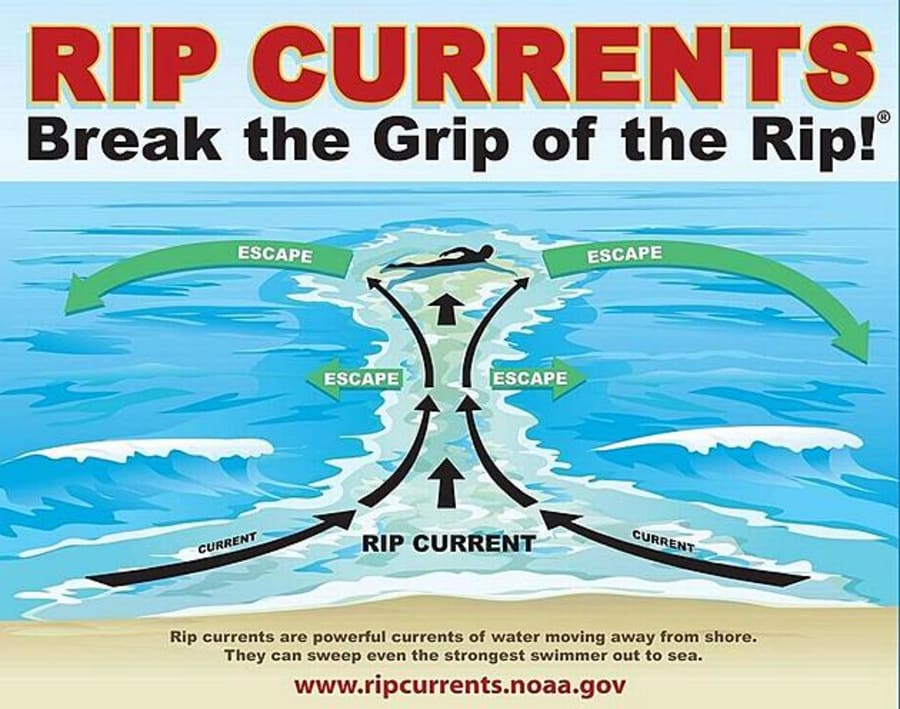JACKSONVILLE, Fla. – As we head into this weekend weekend (the weather looks pleasant, not perfect), I want to remind you of the deadliest weather conditions we see in Florida. I’m talking, of course, about rip currents.
Rip Currents
Recommended Videos
In case you weren’t aware, rip currents actually develop from predictable weather conditions. They’re mostly associated with on-shore winds and certain tidal conditions.
I’ve been investigating this weather issue for well over a decade. It’s the most sinister of deadly weather events — there are no menacing storm clouds, no rapid wind shifts or sudden drops in temperature. In fact, more often than not, we tend to see these rip currents strike when the weather outside is beautiful.
Picture this: the sun is shining and there’s not a cloud in sight. The UV Index is hovering in the 8-10 range, daytime temps are in the 80s, we’ve got a moderate on-shore breeze and surf running in the 2- to 3-foot range. Sounds like the perfect beach day.
But that’s how this trap springs.
The same picturesque conditions that tend to send crowds of people flocking to the beach are the same conditions that are present when rip currents pose the greatest risk. The final ingredient? An outgoing tide, which can cause a rip current to form quickly. But notably, these currents can happen on any tide.
We will see a high tide along area beaches around 12 noon, the outgoing tide will particularly strong around 3 p.m.
In the U.S., the statistics paint a scary picture. Florida, for instance, averages about 18 to 24 deaths a year. That figure is far greater than lightning (five a year), tornadoes (three a year) and hurricanes (roughly 10 a year).
| Surf Zone Deaths (Year) | Rip Currents | High Surf | Sneaker Wave | Other | Unknown | Florida | U.S. |
|---|---|---|---|---|---|---|---|
| 2020 | 65 | 12 | 0 | 16 | 7 | 15 | 100 |
| 2019 | 59 | 16 | 1 | 17 | 8 | 28 | 101 |
| 2018 | 65 | 21 | 0 | 15 | 3 | 26 | 104 |
| 2017 | 70 | 16 | 6 | 10 | 9 | 14 | 111 |
| 2016 | 68 | 25 | 3 | 6 | 6 | 20 | 108 |
| 2015 | 41 | 18 | 1 | 16 | 7 | 25 | 83 |
| 2014 | 82 | 8 | 3 | 6 | 5 | 14 | 104 |
| 2013 (limited data) | 63 | ||||||
| 2002-2012 U.S. annual average | 46 Deaths Annually | ||||||
| 2013-2020 U.S. annual average | 64 Deaths Annually |
(These are federal government statistics, by the way. Check them out, year-by-year, here: 2020, 2019, 2018, 2017, 2016, 2015, 2014, 2013. Earlier values were found here.)
Simply put, rip currents develop after a series of surf waves pile water up onto a shoreline. These waters naturally recede back into the ocean, but they do so by flowing through long depressions, or grooves, along our sandy beaches. This in turn creates a channeling effect that accelerates the water into a stream that pushes straight out to sea.
When people get caught in these streams, they often panic and try to fight the current. But that’s where fear can get the best of us. Instead, try to keep this in mind: stay calm and don’t panic if you feel yourself being pulled farther out.
You can get out of this predicament easily. If you’re in deep water, swim parallel to the beach. If you’re in shallow water, you can try walking up or down the beach. If you lose your footing, don’t worry. Start swimming parallel to the beach. When you feel the current lessen, that’s when you should make your way for shallower depths.
Having experienced some extremely strong rip currents firsthand, I can tell you they fade almost as quickly as they develop. In fact, most rip currents last less than a few minutes.
So, if you’re from out of town for the NFL football game, and want to head to area beaches, keep yourself in shallow water, talk to everyone about rip currents and don’t forget to pack the sunscreen.





